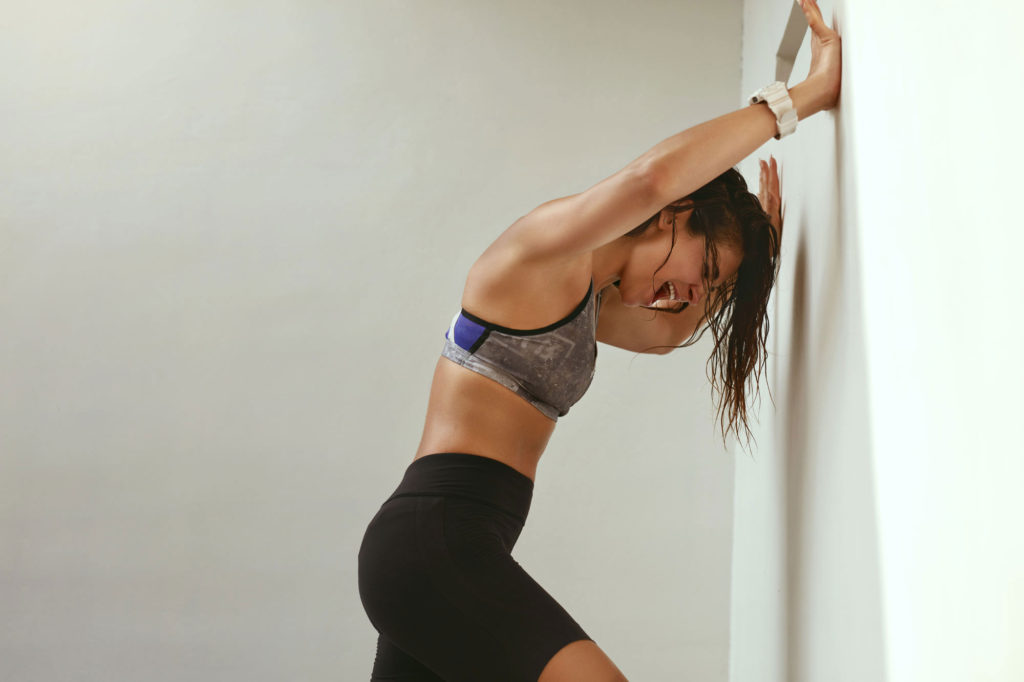
You’ll never doubt how challenging lower body calisthenics can be after this workout. It will round your booty, tone your legs, and leave you breathless—with no added weight.
I honestly didn’t think this workout would be so hard. The joy of keeping track of your own workouts day after day (and year after year) is that as my body changes, certain workouts get harder or easier. And now that I’ve been away from calisthenics for a bit, that sh*t can be extra hard.
As I’ve mentioned, my living situation has me delving into my bodyweight archives this week. I’ve been working out with weights a lot lately, so the change is noticeable and welcome.
Adaptation.
Our bodies are incredible. They’re adaptable, which means that what is hard one day is easier the next, and easier the day after that.
When it’s easier, however, it means your body doesn’t go under as much stress to perform that task. This is good for practical matters, like chopping wood or carrying furniture, but it’s challenging for fitness. It means that in order to improve your fitness, you need to maintain a level of difficulty by evolving your workout strategy.
No pain, no gain, as they say.
There are two ways to use this to your advantage in your fitness journey:
- Change up your workout routine occasionally. If you usually only do calisthenics, add weights. If you do weights, try bodyweight. If you’re used to HIIT, slow things down and concentrate on strength. If you usually do isolation exercises, try compound exercises with kettlebells (and enjoy the metabolic boost). Even just switching to bodyweight, like I did, the focus of the workout and the muscle fibers changed and gave me a much-needed challenge.
- Do the same (or similar) movements, but increase the intensity. With weighted exercises, it’s easy: Increase the weight. You can also change up the reps, add sets, etc.
So how do you increase intensity with bodyweight exercises?
Progressive overload with lower body calisthenics.
With calisthenics, you need to get a little creative, and the lower body in particular provides a unique challenge.
Many calisthenics sources will show you push ups, pull ups and squats as the main core of bodyweight workouts. However, with no added weight, one of those three is not like the others.
Squats. Yeah, bodyweight squats are generally pretty easy, at least in comparison to a pull up, even a push up. Most people can do one bodyweight squat. Most cannot do one pull up.
Progression ideas for lower body calisthenics.
I’ve found four general ways to increase difficulty, and thereby progress your strength, endurance and muscle growth on the lower body with calisthenic exercises. In general, you might find that it takes longer during the workout to “feel” it—feel the muscles reach failure.
That’s okay, as long as you get to that place eventually. There is still much debate about how many reps (high/low) are best for strength and muscle growth, and how close to failure you need to get. With any bodyweight exercises, especially on the lower body, you’re going to need to do a lot of reps (there are exceptions to this, however). Some studies have shown, however, that muscle growth and strength are just as attainable with high-rep circuits as they are with low-rep, so if that is your goal, rest assured that you can still get there with calisthenics alone.
Anyway, what matters more is the time under tension and your fatigue level. So how do we progress in lower body calisthenics?
Single leg exercises.
Lunges are harder than squats, for instance. Even harder are one-legged, or pistol, squats. You’re still lifting the entire body, but you have less muscles to do so on one leg. Add to this the balance component, and the difficulty increases and gets more complicated.
Positioning.
This isn’t so much an increase in difficulty as it is a “try something new” technique, but it still works. Instead of back lunges, do dragon lunges or side lunges. Try a shrimp squat (hover squat) instead of a regular pistol squat. By changing your overall positioning, you work the muscles from a slightly different angle than you are used to.
Plyometrics.
As in, jumping. This is usually my go-to with bodyweight exercises. You ever see that Portlandia sketch “Put a bird on it”? I kind of feel like that with lower body calisthenics sometimes: “Add a jump to it!” It does the trick, and makes it much harder. Bodyweight squats? Not hard. Bodyweight jump squats? They get tiring after 15 or 20 or 30.
Time under tension.
This is a very general rule, and there are many ways to do this. Check out my post, “11 Ways to Make Exercises Harder (Without Adding Weight)” for a fuller explanation. You can add isometrics, pulses, slow down the tempo, do a high amount of repetitions, decrease rest time or combine exercises so that the height of the exercise’s difficulty lasts longer. This is extremely effective, especially when you aren’t able to do plyometrics due to joints or living issues (like downstairs neighbors).
Adding non-weighted equipment.
I almost didn’t add this one because it does feel like cheating a bit. I mean, it’s not weight, but it is adding resistance with an outside object. And is it technically calisthenics if you add equipment? Yeah, but… still. But with the lower body, we need all the help we can get. In this workout, I use resistance bands. Sometimes, it just helps the exercise along, but sometimes (like with walking abductions), it’s needed. For a lower body bodyweight workout, it helps a lot to balance focus between the glutes and the quads. You can also add equipment like medicine balls (for instability), discs, pull-up bar, dip station, parallel bars, and lots more.
Today’s lower body bodyweight workout.
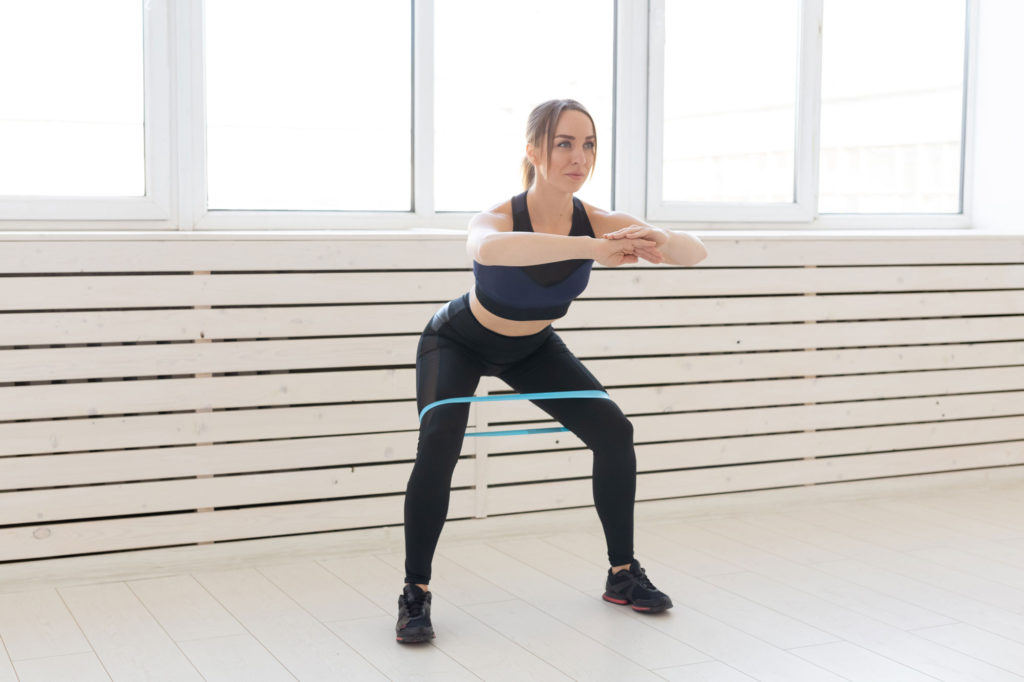
This workout I named “Leave Me Breathless” because it did just that. With added plyometrics, high volume of similar exercises and little rest, I felt almost like I had been sprinting. This isn’t uncommon in lower body calisthenics workouts, due to the need for increased reps and plyometrics, but it still caught me by surprise.
Part 1 keeps the legs and glutes constantly working with its structure, which provides no rest. That sounds harsh, but the second interval is much easier than the first. With plyometrics and a pulse in there which lengthens the time under tension, the 50-second interval is pretty rough. The 30-second “rest” is a much lower intense exercise, but it’s made more difficult because the muscles are fatigued from the first interval.
It’s not the most exciting, because you do those two exercises back to back for 13 minutes. But then we get to Part 2, with the motherlode of lower body calisthenics exercises: the pistol (or one legged) squat. Follow the video for suggestions of modifications, or check out my post here. Vertical leaps follow that, which are very explosive, and so very metabolic, but you’ll feel the quad burn in there. Finishing up the round is one of my favorite metabolic glute exercises: the Bulgarian jump squat. With three rounds instead of an HIIT format, you can relax a little on time and watch your form here.
I added a bonus because this workout is amazing as is, but since I’ve lost my pregnancy weight, I’ve also lost, um… my booty. Set the timer and do all four parts, taking note of each couplet’s time if you wish. It’s a nice burnout that also has some cardiovascular benefit, too, thanks to the added plyometrics in there.
So, let’s do this!
Instructions.
Leave Me Breathless Workout
Part 1
50&30×10
- Static jl and pulse L
- Side lunge and kick up L
- Static jl and pulse R
- Side lunge and kick up R
Part 2
3 rounds
- One leg squat L – 10
- One leg squat R – 10
- Vertical leaps – 20
- Bulgarian jump squat L – 15
- Bulgarian jump squat R – 15 (original was 30 swings instead of these bulgarian jump squats)
Glute Workout Add-On
Each couplet is 3 rounds. But time them all together.
A:
- Single leg bridge L – 15
- Single leg bridge R – 15
B:
- Walking abductions – 16
- Jump squat (banded) and booty pulse – 16
C:
- Banded donkey kick L – 20
- Banded donkey kick R – 20
D:
- Side lunge and jump up L – 15
- Side lunge and jump up R – 15
Exercise Instructions and Video.
Watch the video, here, or read below for descriptions of the exercises.
Static jump lunge and pulse.
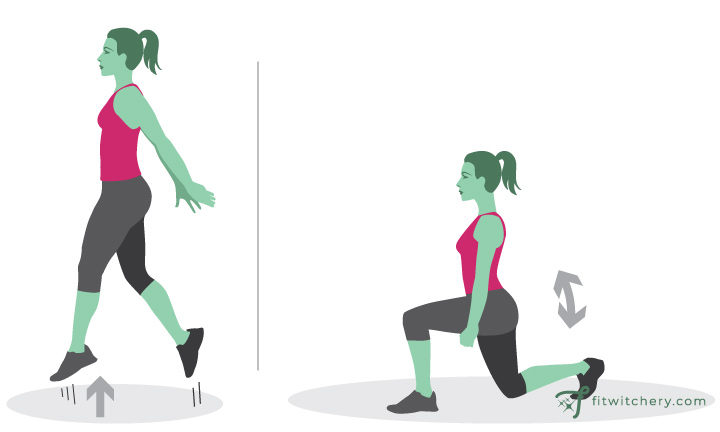
With one leg in front of the other, go down in a lunge, pulse once, feeling it in your booty, then jump up on both feet and come back down with legs in same position.
Side lunge and kick up.
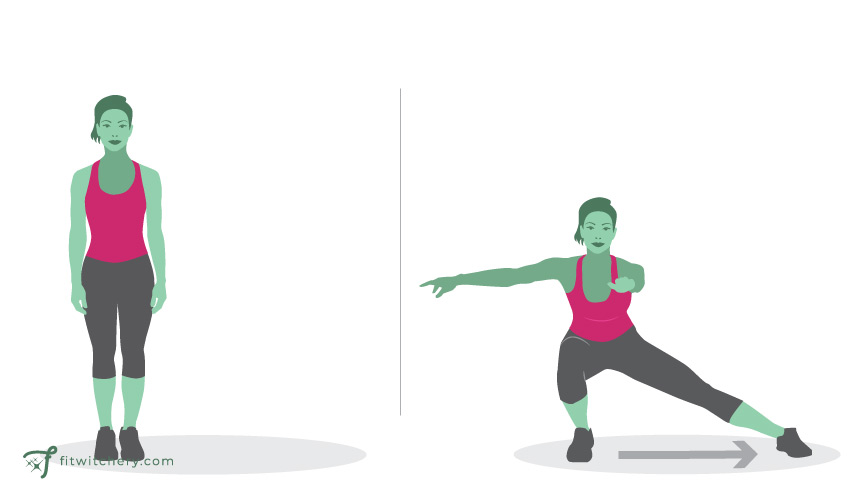
Lunge on one leg with the other leg out to the side. Go down until thigh is about parallel, then stand back up, kicking other leg up as high as you can.
One leg squat.
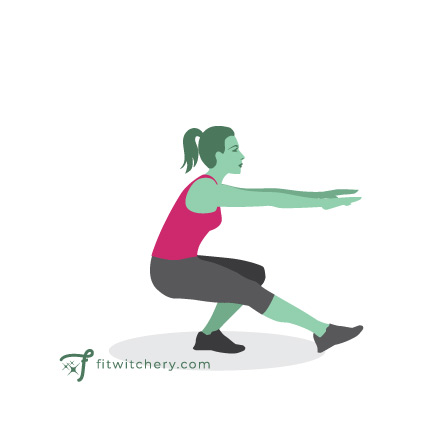
Squat down on one leg with the other pointing in front of you. Come down so thighs are parallel (half), or if you can, go down all the way. Return to standing. (See my post on pistol squats for more information and modifications. I also go over this in the video.)
Vertical leaps.

Go down into a squat, bend forward slightly with arms behind you. Jump up in the air and think of extending your hands and feet slightly behind you.
Bulgarian jump squats.
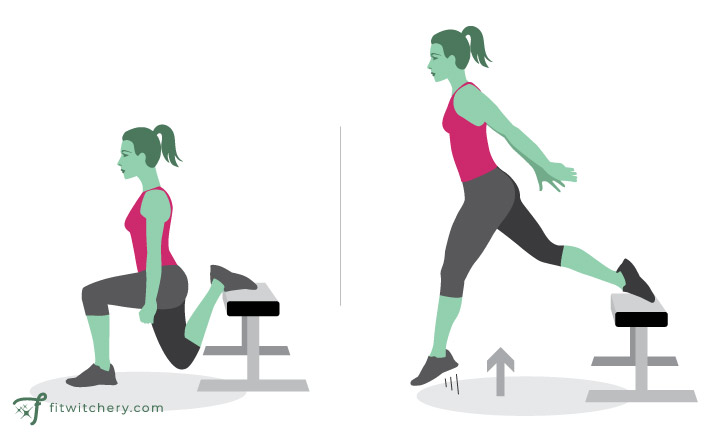
Stand with one foot resting on a chair or step behind you. Do a lunge, pushing weight through the heel of your front leg’s heel. Jump up. Come down immediately into next rep.
Bonus exercises.
Single leg bridge.
Lie on ground with one leg bent and one leg pointing up. Lift butt from ground with the bent leg by pushing through your heel.
Walking abductions.
With a band around your legs (above knees, around calves or both), go into a half squat and take a step sideways. Bring the other leg in and continue taking lateral steps for as much as your space will allow (I usually do 4), then reverse direction. You should make sure your knees are pushing outward as you go, that you stay low the entire time, and that you feel your glutes contracting.
Banded jump squat and pulse.
With the same bands around your legs, sit your butt down and back, keeping torso relatively upright, and pulse up and down. Make sure your weight is in your heels and your knees don’t come far over your toes. From this position, jump up. Go right into next rep.
Donkey kick.
Get on all fours, and if you like, keep a band around your knees for added difficulty. Make sure you’re at right angles at your shoulders, hips and knees. Keeping your spine straight, lift one leg upwards, still at a right angle. Pulse your heel upward, squeezing your glute.
Side lunge and jump up.
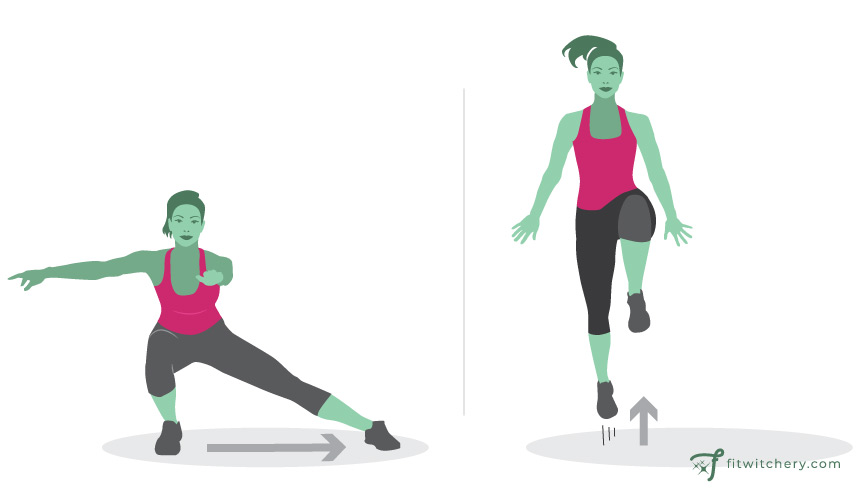
Lunge on one leg with the other sticking out to the other side. Go down until thigh is about parallel, then jump up, bringing other knee in and up and return to lunge position. Continue on same side.
Related lower body calisthenics posts:
- Why Calisthenics Should Always Be a Part of Your Workout Program
- 11 Ways to Make Exercises Harder (Without Adding Weight)
- How to Do a Pistol Squat | Progression and Alternatives
- Progressive Overload: Why You Need It in Your Fitness Program
- Bodyweight Supersets: The Fast Track to Bodyweight Strength
- This 35 Minute HIIT Workout Will Make You Fall in Love With Bodyweight
